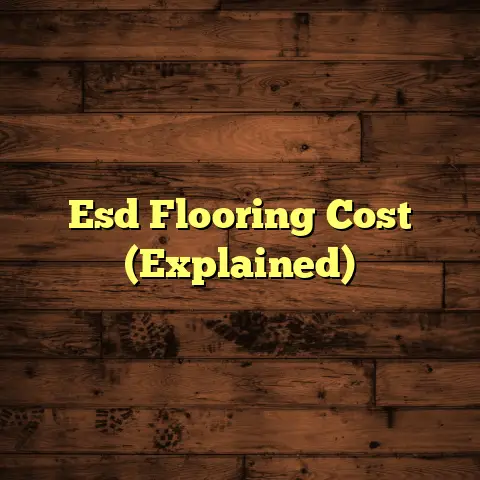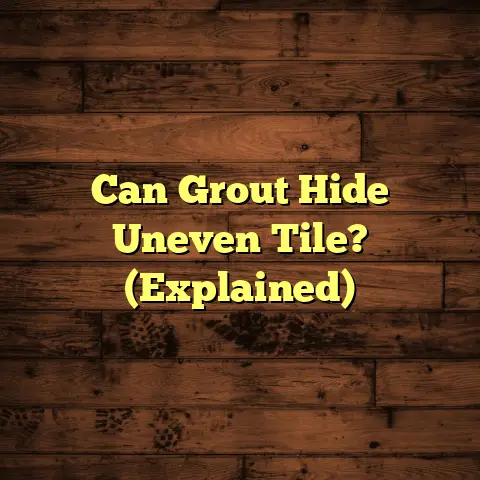Power Wash Wood Floors? (7 Risks Exposed!)
Do you remember your childhood home?
I do. I can almost smell the faint scent of lemon polish and hear the satisfying thunk of my dad’s work boots on the gleaming hardwood. Sunlight used to stream through the windows, reflecting off the polished surface, creating a warm and inviting space. Those floors weren’t just floors; they were the foundation of our home, a testament to quality and timeless beauty.
And that’s what wood floors are, right? An investment, a statement. But like any investment, they need the right care. And that’s where things can get tricky. Especially when we start talking about “quick fixes” like power washing.
Trust me, I’ve seen it all in my years as a flooring contractor. So, let’s dive into why power washing wood floors is usually a really bad idea.
Understanding Wood Floors
Before we get into the nitty-gritty of power washing gone wrong, let’s talk wood.
Types of Wood Floors
You’ve got a few main players here:
-
Solid Hardwood: The OG. This is the real deal – planks milled from a single piece of wood. It’s durable, beautiful, and can be refinished multiple times. Think oak, maple, cherry, etc.
-
Engineered Wood: This is like a plywood sandwich with a hardwood veneer on top. It’s more stable than solid hardwood, especially in areas with high humidity, and often a bit more budget- friendly.
-
Laminate: Okay, this isn’t real wood. It’s a synthetic material with a photographic layer that looks like wood. It’s the most affordable option, but it’s also the least durable and can’t be refinished.
Each type has its own personality and needs slightly different care. A solid hardwood floor can handle a light sanding and refinishing, while a laminate floor? Not so much.
The Appeal of Wood Floors
Why do people love wood floors?
Well, where do I even start?
-
Aesthetics: They’re simply beautiful. Wood adds warmth, character, and a touch of elegance to any space.
-
Durability: Properly maintained wood floors can last for decades, even centuries!
-
Value: Wood floors increase the value of your home. It’s an investment that pays off.
-
Versatility: They work with almost any décor style, from modern to rustic.
It’s no wonder that homeowners are increasingly choosing wood floors. According to the National Wood Flooring Association (NWFA), the wood flooring market has seen consistent growth over the past decade, with a projected market size of over \$4 billion in the coming years. [Source: NWFA Industry Outlook Report]
But this popularity also means more people are looking for ways to keep those floors looking their best. And that’s where the temptation of power washing comes in.
The Power Washing Trend
Alright, let’s talk about the elephant in the room: power washing.
What is Power Washing?
Power washing, also known as pressure washing, uses a high-pressure stream of water to clean surfaces. It’s incredibly effective at blasting away dirt, grime, and even things like mildew and algae.
You see it used everywhere: driveways, decks, siding… it’s become a go-to for outdoor cleaning. But just because it works on concrete doesn’t mean it’s safe for your precious wood floors.
Why Some Consider Power Washing Wood Floors
So, why would anyone even think about power washing wood floors?
I get it. The appeal is there:
-
Deep Cleaning: The idea is that the high pressure will get rid of embedded dirt that regular cleaning can’t touch.
-
Stain Removal: People hope it will blast away stubborn stains.
-
Revitalization: Some think it will bring back the original luster of the wood.
It sounds tempting, right? A quick, easy way to make your floors look brand new. But trust me, the risks far outweigh the potential benefits.
Risks of Power Washing Wood Floors (7 Risks Exposed)
Okay, here’s where I put on my “expert contractor” hat and tell you why this is a terrible idea. I’ve seen the damage firsthand, and it’s not pretty.
Risk 1: Water Damage
Wood and excessive water are not friends. They’re like oil and water, cats and dogs, you get the picture.
When you power wash wood floors, you’re forcing a lot of water into the wood. This can lead to:
-
Warping: The wood absorbs the water and expands, causing it to warp and become uneven.
-
Swelling: Similar to warping, the wood can swell, leading to buckling and separation of the planks.
-
Mold Growth: Moisture trapped in the wood creates the perfect breeding ground for mold and mildew. And trust me, you don’t want to deal with mold. It’s expensive to remediate and can cause serious health problems.
According to the EPA, mold growth can begin within 24-48 hours in moist environments. [Source: EPA Guide to Mold Remediation]
Risk 2: Loss of Finish
That beautiful protective layer on your wood floors? Gone. Reduced to atoms.
The high-pressure water can strip away the finish, leaving the wood vulnerable to damage. This means:
-
Increased Susceptibility to Scratches: Without the finish, the wood is easily scratched and dented.
-
Increased Absorption of Stains: The wood becomes more porous and absorbs stains like a sponge.
-
Fading: The finish protects the wood from UV damage. Without it, the wood can fade and discolor over time.
Risk 3: Surface Scratches and Dents
Even if the power washer doesn’t completely strip the finish, it can still cause significant surface damage.
The force of the water can create scratches and dents, especially on softer woods like pine. These imperfections not only detract from the appearance of the floor but also create areas where dirt and grime can accumulate.
Risk 4: Ineffective Cleaning
Believe it or not, power washing might not even be that effective at cleaning your wood floors.
While it can remove surface dirt, it often fails to get rid of embedded grime and stains. The water pressure can actually force dirt deeper into the wood pores, making it even harder to remove later.
Risk 5: Chemical Damage
Some people add cleaning solutions to their power washer to supposedly enhance the cleaning power. Big mistake.
Many cleaning solutions contain harsh chemicals that can damage the wood or the finish. These chemicals can cause:
-
Discoloration: Staining or bleaching the wood.
-
Etching: Creating a dull, uneven surface.
-
Weakening: Compromising the structural integrity of the wood.
Always check the label before using any cleaning product on your wood floors. And when in doubt, test it in an inconspicuous area first.
Risk 6: Structural Integrity Compromise
Repeated power washing can weaken the structural integrity of your wood flooring over time.
The constant exposure to water and high pressure can cause the wood to become brittle and prone to cracking. This is especially true for older floors that have already been exposed to years of wear and tear.
Risk 7: Cost Implications
Let’s talk money. Because ultimately, that’s what it often boils down to.
The cost of repairing or replacing damaged wood floors as a result of power washing can be astronomical. You’re looking at:
-
Professional Repairs: Fixing warped planks, sanding and refinishing, repairing water damage.
-
Complete Replacement: If the damage is extensive, you might have to replace the entire floor.
According to HomeAdvisor, the average cost to install hardwood floors ranges from \$6 to \$12 per square foot. [Source: HomeAdvisor Hardwood Flooring Costs]
So, before you even think about power washing your wood floors, ask yourself if you’re willing to gamble with that kind of money.
Alternatives to Power Washing Wood Floors
Okay, I’ve scared you enough, right?
But don’t worry, there are plenty of safer, more effective ways to clean and maintain your wood floors.
Traditional Cleaning Methods
-
Sweeping/Vacuuming: Regular sweeping or vacuuming is the first line of defense against dirt and debris.
-
Damp Mopping: Use a damp (not wet!) mop with a wood-specific cleaner. Make sure to wring out the mop thoroughly to avoid leaving excess water on the floor.
-
Wood-Specific Cleaners: These are formulated to clean wood floors without damaging the finish.
-
Spot Cleaning: Clean up spills immediately to prevent staining.
Professional Services
Sometimes, you just need to call in the pros.
Professional floor cleaning services have the equipment and expertise to deep clean your wood floors without the risks associated with power washing. They can also provide other services, such as sanding, refinishing, and sealing.
Conclusion
Wood floors are an investment, a statement, and a beautiful addition to any home. They deserve to be treated with care and respect.
While power washing may seem like a quick and easy solution for cleaning your wood floors, it poses significant risks that can lead to costly repairs and detract from the floor’s natural charm.
So, the next time you’re tempted to grab that power washer, remember what I’ve told you here. Take a step back, consider the alternatives, and choose a safer, more effective method for cleaning and maintaining your wood floors.
Your floors (and your wallet) will thank you for it. And who knows, maybe one day, someone will walk into your home and marvel at the beauty and timeless appeal of your perfectly preserved wood floors.





